Vol.3 Issue No.1 (2007): Journal of Indian Society of Toxicology
From TOXOCON-3 to TOXOCON-4 and Beyond
With the number of life members of IST touching 150, and 3 national conferences successfully accomplished, it was felt that certain amendments were necessary in order to curb the burgeoning membership, while at the same time generate more revenue for the Society and its journal. The following amendments were therefore proposed, which were subsequently ratified by the Executive Committee unanimously:
1. Enhancement of Life Membership fee from Rs. 2500/- to 3000/-, and Annual Membership fee from Rs. 250/ - to Rs.300/-
2. Only Life Members will be eligible for free copies of JIST. Annual Members must pay Rs. 100/- per issue, while non-members must pay Rs. 500/-.
3. Reduction of seed money for holding every subsequent edition of TOXOCON (to the Organizing Secretary) from Rs. 20,000/- to Rs. 15,000/-.
These amendments will come into force from the new financial year (April 2007). The audited accounts for the financial year 2006-2007 have been submitted to the Society's Executive Committee.
In keeping with our commitment to showcase a particular aspect of poisoning in each issue of TOXOCON (the annual conference of the Society), TOXOCON-3 which was held at Mangalore, Karnataka, on 07 & 08 April 2007 focussed on pesticides, with particular reference to organophosphates and carbamates. The idea was the same as in the case of its forerunner: to develop an effective protocol for the management of poisoning with these compounds, that will be disseminated subsequently through IST and other professional organizations to all major hospitals in the country. The protocol is now ready, and is available at a nominal price to all interested physicians and hospitals (details mentioned on page 40).
For TOXOCON-4, we will deviate slightly and take up an issue that just cannot wait: development of an effective curriculum in toxicology for undergraduate and postgraduate medical education, on the basis of which each medical college can re-design the syllabus, thereby giving the existing atrocious scenario a decent burial. The new curriculum will be sent to the Medical Council of India for approval and ratification.
As far as our journal (JIST) is concerned, the progress has been very good, both with regard to the printed as well as the online version (available for access through www.indianjournals.com), and the subscription base is widening not only in India, but also abroad.
All in all, not a bad state-of-affairs so far, but then to use a hackneyed cliché - we have miles still to go…………..


